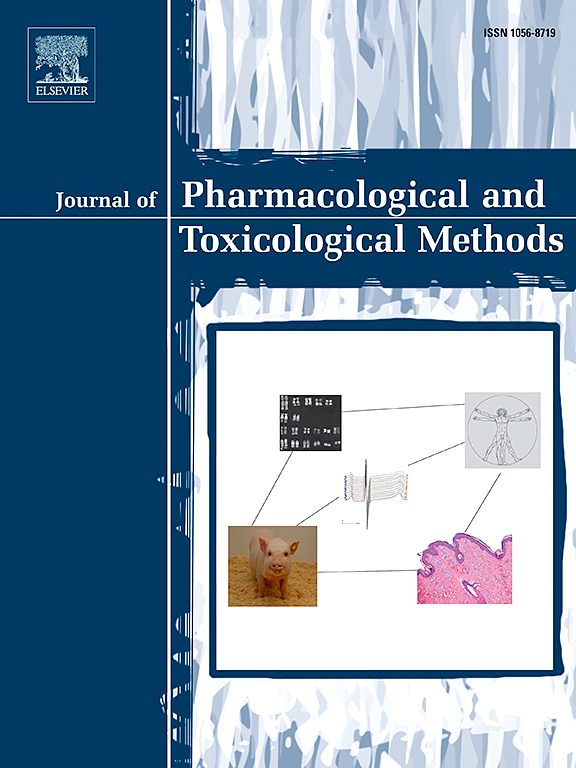JET, but not ‘snapshot’, analysis is sensitive enough to detect effects at critical concentrations of ondansetron and moxifloxacin in dog
IF 1.3
4区 医学
Q4 PHARMACOLOGY & PHARMACY
Journal of pharmacological and toxicological methods
Pub Date : 2025-05-01
DOI:10.1016/j.vascn.2025.107605
引用次数: 0
Abstract
Jacketed external telemetry (JET) is an important technology allowing access to continuous ambulatory electrocardiogram data in settings in addition to standalone cardiovascular safety pharmacology studies such as GLP toxicology studies. In developing oncology therapeutics under ICH S9 it may also be the case that QTc data collected during toxicology studies is the only in vivo data available to support an integrated risk assessment under the new ICH E14 Q6.1. The current analyses compared JET in freely moving dogs with more conventional ‘snapshot’ collections in restrained, recumbent animals for the same group of 24 beagle dogs (12 M, 12F). The treatments tested were vehicle, ondansetron (3 and 10 mg/kg), and moxifloxacin (30 mg/kg). A parallel study design (3 animals per sex per group) was used in the comparison of JET and ‘snapshot’ collection. In a subsequent phase of the study the 12 male dogs were rotated through the other treatments to create a Latin square crossover analysis. The higher dose of ondansetron achieved Cmax exposures consistent with the clinical critical concentration associated with a 10 ms QTc prolongation. The tested dose of moxifloxacin was the same as that tested in previous studies and achieved a Cmax concentration ~ 3-fold the critical concentration associated with a 10 ms QTc prolongation and had sustained exposure throughout the 24 h telemetry collection period. No treatment related QTc effects were detected using ‘snapshot’ data collection. The small heart rate increase following moxifloxacin detected using JET was not detected in the ‘snapshot’ analysis. Statistically significant, treatment-related QTc prolongation was detected for both doses of ondansetron and moxifloxacin in the parallel and the cross-over JET data analyses. The study-specific least significant difference was 7.1 ms and 2.6 ms for these analyses, respectively. JET data collection and analysis in a parallel toxicology-like design proved sensitive enough to support ICH E14 Q6.1 integrated risk assessment. Conventional ‘snapshot’ analysis was not sufficiently sensitive to detect a treatment-related effect even for modest multiples of the human critical concentrations.
JET(而不是“快照”)分析足够灵敏,可以检测到临界浓度的昂丹司琼和莫西沙星对狗的影响
除了独立的心血管安全药理学研究(如GLP毒理学研究)外,夹克外遥测(JET)是一项重要的技术,可以在设置中获得连续的动态心电图数据。在根据ICH S9开发肿瘤治疗药物时,也可能出现毒理学研究期间收集的QTc数据是唯一可用于支持新ICH E14 Q6.1下综合风险评估的体内数据。目前的分析比较了自由运动犬的JET与更传统的“快照”收集,同一组24只比格犬(12 M, 12F)。试验处理为对照、昂丹司琼(3和10 mg/kg)和莫西沙星(30 mg/kg)。采用平行研究设计(每组每性别3只动物)比较JET和“快照”收集。在研究的后续阶段,12只雄性狗轮流接受其他治疗,以创建拉丁平方交叉分析。较高剂量的昂丹司琼达到了Cmax暴露,与10 ms QTc延长相关的临床临界浓度一致。莫西沙星试验剂量与以往研究相同,Cmax浓度 ~ 为延长10 ms QTc的临界浓度的3倍,并在24 h遥测采集期间持续暴露。使用“快照”数据收集未检测到与治疗相关的QTc效应。使用JET检测莫西沙星后的小心率增加在“快照”分析中未被检测到。在平行和交叉JET数据分析中,两种剂量的昂丹司琼和莫西沙星均检测到与治疗相关的QTc延长,具有统计学意义。在这些分析中,研究特异性最不显著差异分别为7.1 ms和2.6 ms。平行毒理学设计的JET数据收集和分析证明足够敏感,可以支持ICH E14 Q6.1综合风险评估。即使对人体临界浓度的适度倍数,传统的“快照”分析也不够敏感,无法检测到治疗相关的影响。
本文章由计算机程序翻译,如有差异,请以英文原文为准。
求助全文
约1分钟内获得全文
求助全文
来源期刊

Journal of pharmacological and toxicological methods
PHARMACOLOGY & PHARMACY-TOXICOLOGY
CiteScore
3.60
自引率
10.50%
发文量
56
审稿时长
26 days
期刊介绍:
Journal of Pharmacological and Toxicological Methods publishes original articles on current methods of investigation used in pharmacology and toxicology. Pharmacology and toxicology are defined in the broadest sense, referring to actions of drugs and chemicals on all living systems. With its international editorial board and noted contributors, Journal of Pharmacological and Toxicological Methods is the leading journal devoted exclusively to experimental procedures used by pharmacologists and toxicologists.
 求助内容:
求助内容: 应助结果提醒方式:
应助结果提醒方式:


